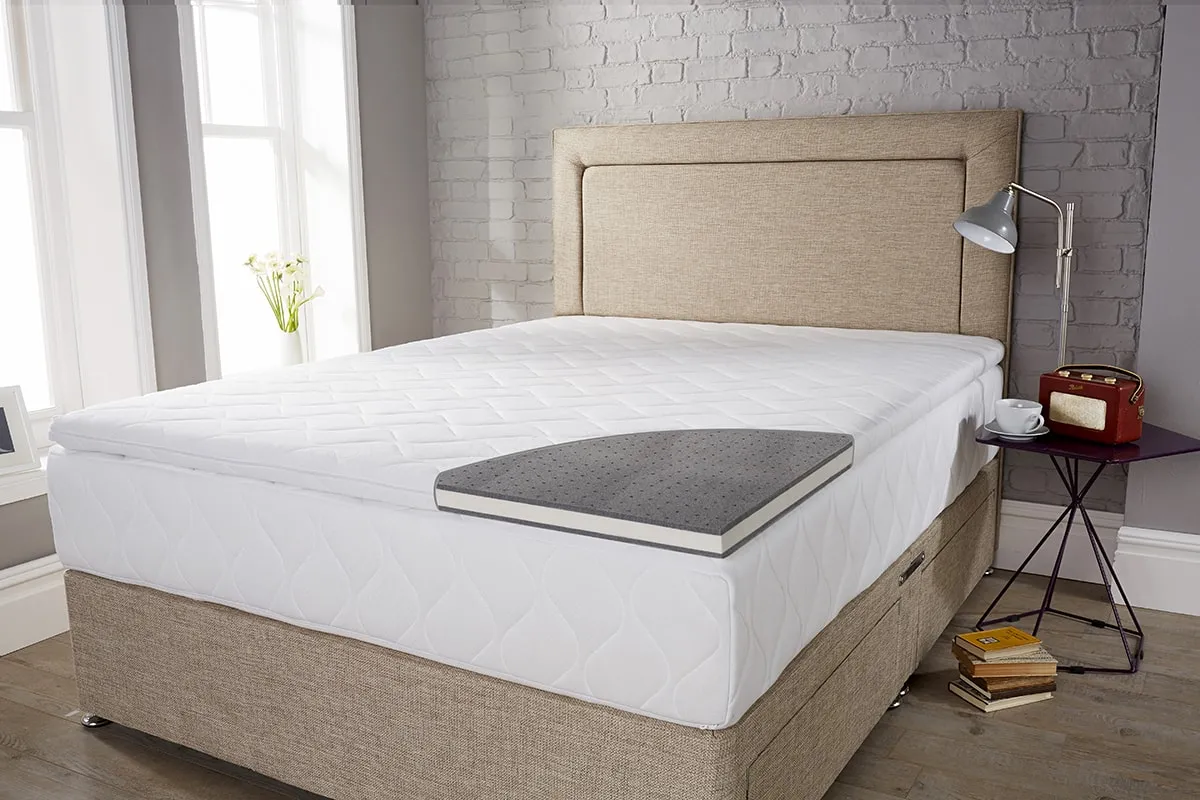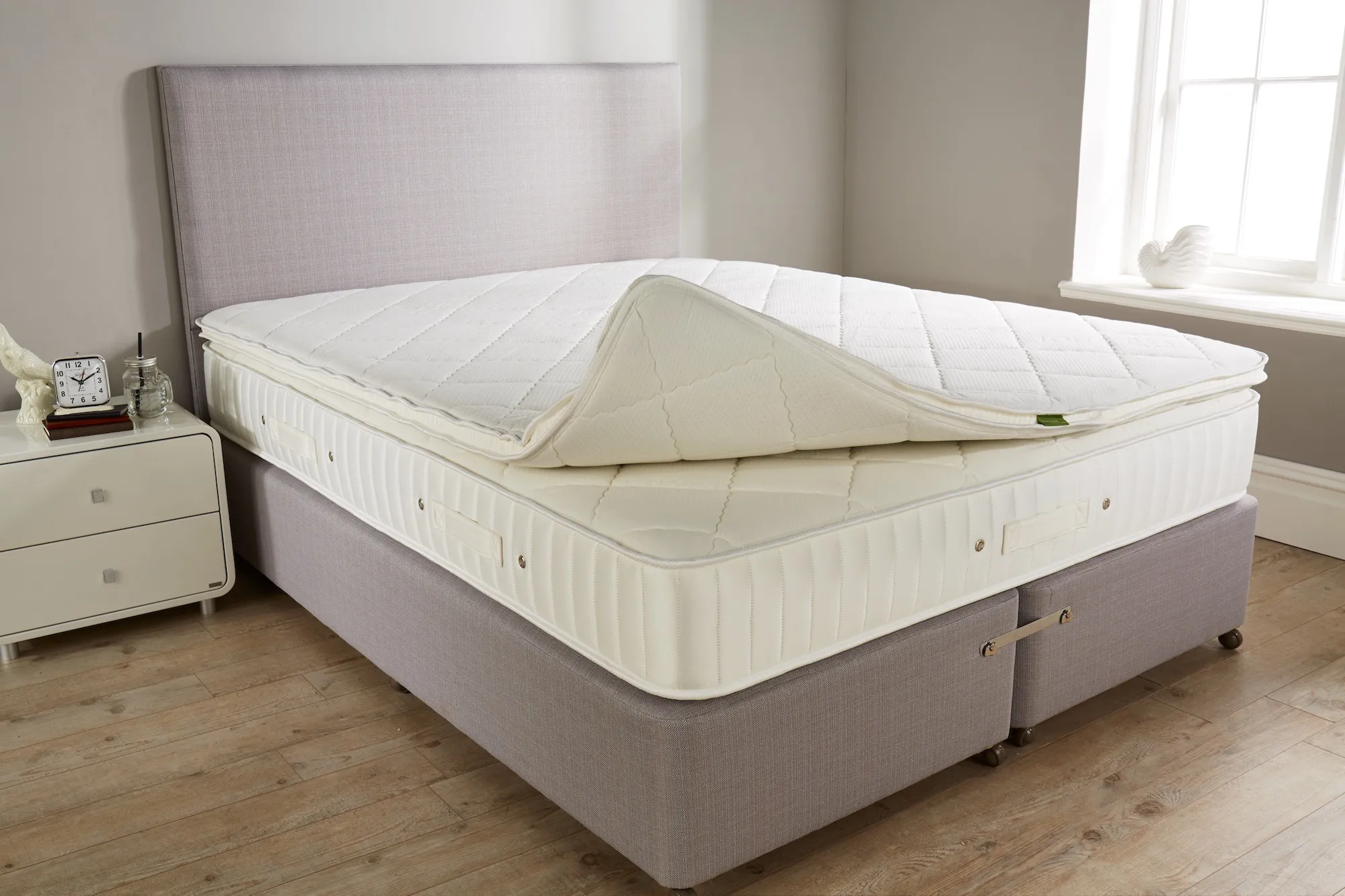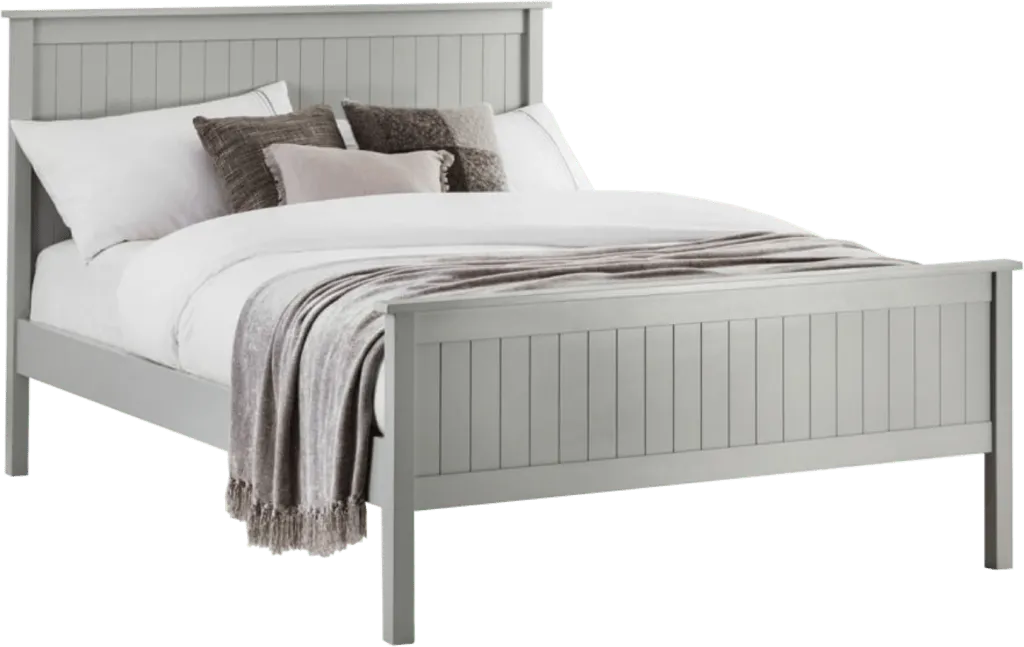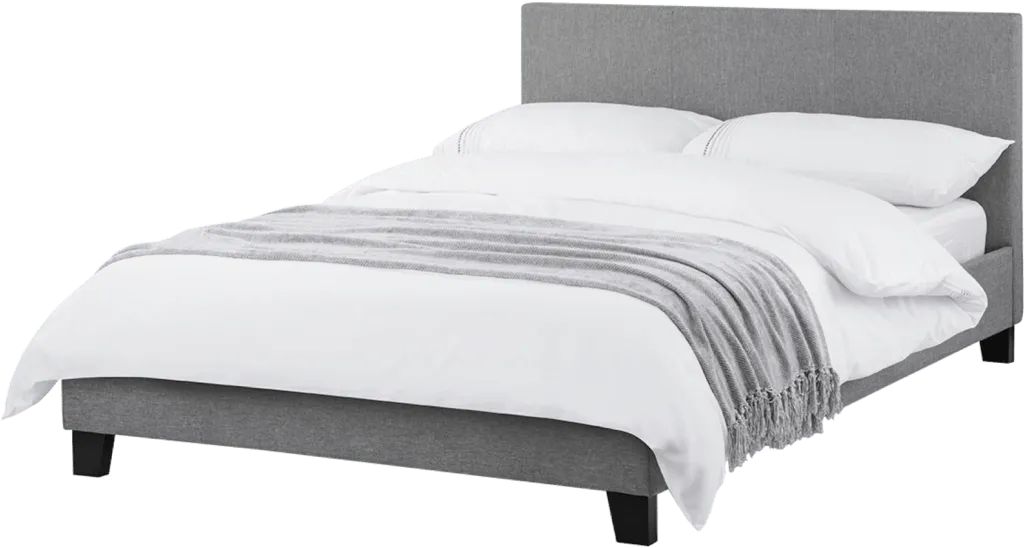What is the construction method for mattress toppers?
Jump to:
- Types of Mattress toppers
- Considerations before buying a Mattress topper
- The importance of trying your Mattress without a topper first
- Matching your topper to your Mattress
The general rule of construction is that the upholstery used to make the topper should be ‘in keeping’ with what is used as the primary layer within the mattress. A topper is usually softer to give a deeper comfort layer to your mattress.

Many people contact us in confusion over mattress toppers.
- Should I get one?
- What do they do?
- Which topper should I buy to go with my new John Ryan mattress?
- How many toppers do I need?
We always advise that in most instances you should try a mattress without a topper first. Though we recommend all mattresses use a protector at all times, not to be confused with a topper!
Mattress protectors: A mattress protector functions as a protective barrier and is usually a relatively cheap polyester cover that fits over the mattress to protect it from sweat, moisture and damage. You can either wash or replace this when it becomes dirty or worn out.
Mattress toppers: Toppers serve as an extra layer on top of your mattress and are primarily designed for added comfort and support.
Types of Mattress Toppers
When it comes to mattress toppers, there are a few main types to consider based on the material and construction.
- Memory Foam Toppers – Memory foam toppers are made from viscoelastic polyurethane foam and are a popular choice thanks to their ability to conform closely to the body for pressure relief and support. They cushion pressure points and isolate motion well, whilst also providing good overall comfort and pain relief. However, some people find that memory foam retains heat. If you’re a hot sleeper then this can be a problem, but if you want to keep warm during the night then a memory foam topper could be an option.
- Latex Toppers – Natural latex rubber foam is an eco-friendly, responsive, and breathable mattress topper option. It provides contouring and bounce, and relieves pressure while allowing easier movement. These toppers sleep cooler than memory foam and are naturally antimicrobial and dust mite resistant. However, latex does not retain impressions like memory foam, and it can be more expensive.
- Feather Toppers – Feather toppers give a soft, fluffy feel with extra padding. The filling conforms loosely to the body and helps to relieve pressure points. However, feather toppers don’t offer the same motion isolation or support as other materials. They also require fluffing to maintain lift and prevent impressions.
- Wool – Typically made from sheep’s wool, wool toppers help to regulate temperature, keeping you cool in the summer and warm in the winter. They also possess natural hypoallergenic properties and are resistant to dust mites.
- Microfibre – These are constructed with synthetic fibres like polyester and are usually more budget-friendly than other materials. Like wool, microfibre mattress toppers are also hypoallergenic and resistant to dust mites. Although they don’t offer the same level of support as memory foam or latex, they do provide a soft comfortable layer for your mattress at a good price.
Considerations before buying a Mattress Topper
Purchasing a new mattress topper can be confusing due to all the options on the market, so we’ve noted some key factors to keep in mind when you’re trying to select the best mattress topper for your needs:
Thickness: Mattress toppers typically range from 2-4 inches thick. Thinner 1-2 inch toppers add a little extra cushioning, while thicker 3-4 inch options provide a more substantial level of comfort.
Materials: Whichever material you choose – whether that’s memory foam, latex, feather, wool or cotton – they all have their own unique properties. Compare materials that will work best for your sleep position, firmness preference, temperature regulation, and allergies.
Mattress compatibility: Make sure to choose a mattress topper that’s designed to work well with your specific mattress type. For example, memory foam works best on top of innerspring or hybrid mattresses. Latex and feather toppers can work for most mattresses.
Size: Check your exact mattress dimensions before buying since toppers come in sizes like twin, queen, king, etc. They should cover your mattress surface evenly without overhanging.
Your sleeping preferences: Since your body will be resting on your mattress topper every night, you should consider your sleeping habits. For example, side sleepers may benefit from memory foam as it contours the body and aligns the spine, while back sleepers might prefer the support that’s provided by a latex topper. Similarly, gel-infused memory foam can be a great option for those who tend to sleep hot.
Allergies and sensitivities: If you have allergies or sensitivities, opt for hypoallergenic materials such as latex, wool, or microfibre. They also resist dust mites and allergens.
The importance of trying your Mattress without a topper first
Before your rush to buy a mattress topper, it’s wise to first spend a few nights sleeping on your new mattress alone. This lets you experience the feel and support of the mattress surface without any extra layers. Mattress toppers are designed to soften the sleep surface and add extra comfort. However, if you add a topper too quickly, you may end up with a mattress that feels too soft and lacks adequate support, leading to back pain and poor sleep quality.
Spending a week or two adjusting to your new mattress gives you a chance to break it in and determine if you really need any modifications. You may find that you love the balance of comfort and support from your standalone mattress. Or, you may discover that you want the slightly softer surface that a topper provides.
Taking the time to test out your mattress means you can pinpoint where you want extra cushioning and what firmness level will work best. This prevents over-softening the bed or spending more than needed. A little patience upfront ensures you select the perfect topper for your mattress.
Matching your topper to your mattress
Our advice is that any topper bought to go with your mattress should follow the same fibres or components found in your mattress. This is especially true for 100% natural mattresses. If your mattress is natural then you should stick to natural fibres. After all, you don’t want to cover a hand made Artisan mattress, which is 100% natural, with a cheap polyester layer! You could use, for example, a natural fibre such as cashmere wool if you so wished, but we would avoid synthetic fibres in this example. It’s really important that you choose a topper that works with the original mattress construction and not against it!
Memory foam toppers work well with innerspring and hybrid mattresses. The springs provide support, while the memory foam cushions pressure points. The foam also dampens excess bounce from the coils. Just don’t use memory foam with a mattress that’s too soft or it may exacerbate sagging.
We find that latex foam or wool toppers pair nicely with latex mattresses as they offer pressure relief and breathability. Cheaper polyester toppers tend to compress very quickly but are a lot cheaper. You really do get what you pay for, so bear this in mind.
For air mattresses, stick with a firm and breathable topper like cotton, wool, or very dense foam. Soft toppers could compress into the air chambers and feel unstable. If you have a pillow top mattress, select a thinner topper that’s under 3 inches so you don’t end up with a surface that’s too plush. Something like a 2-inch latex topper offers a bit of extra cushioning without going overboard.
We tend to find that one topper is usually enough. That said, if you want that extra deep soft sink then the more the merrier!


Many of the high street retailers don’t recommend toppers or, if they do, they permanently stitch the topper to the mattress, completely removing the longevity benefit. Retailers that do sell them often are selling products without explaining the benefits, drawbacks or product details, leaving you once again confused and scratching your head.
Top end foam bed companies (such as Jensen) use toppers in their top end mattresses, commanding a high-end price: £3000 plus in some cases. They do provide some truly excellent products, but are simply out of the reach of some budgets. Again, you are paying a premium for these products and, in some cases, some topper retailers still won’t tell you the exact depths and densities of their toppers. These are really important. At John Ryan by Design, we provide you with all the details, benefits, drawbacks and advice when choosing a topper from our range.
If you have read the techniques of mattress construction, you will know that, as you get higher up the mattress, the material should get softer. The topper, however, can be firmer or softer as it’s a separate part of the mattress. We have matched our toppers to the mattress bases to provide the best progressive comfort, as we have tried and tested the combinations that work well together.
The key to getting the most out of a mattress topper is choosing one that complements your existing mattress perfectly. If your mattress is too firm, a softer memory foam or feather topper can help relieve pressure points and make it more plush. If it feels too soft and saggy, consider a firmer latex or wool topper to provide extra support. Mattress toppers used in this fashion can only tweak a bed and not completely restore it. Our guidance is to make sure you buy a topper alongside your mattress to enable the two to fully work together.


Ask us a question.
There are over 6000 questions and answers submitted by you on all questions about mattresses and bed problems. Enter a keyword such as Vi Spring, John Lewis beds, bad back or Memory Foam and see if your question has already been answered.
You can filter popular questions by the categories below. If you can’t find an answer, ask a new question below. We aim to respond to all questions within one working day.




































 Mattresses
Mattresses  Take our mattress quiz
Take our mattress quiz  Contact
Contact  About us
About us 



